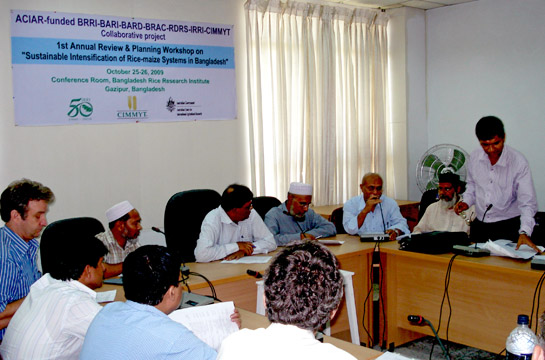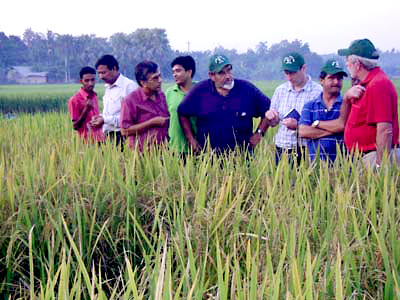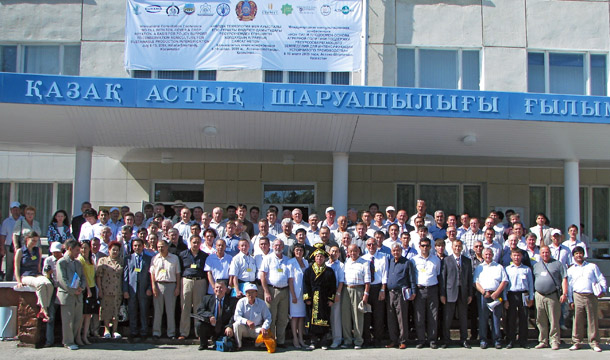From 28 February to 3 March, the Global Maize Program (GMP) team and participants from the Socioeconomics and Genetic Resources programs (forming ‘GMP Plus’) were in Harare, Zimbabwe for their annual review and work planning meeting. It was a good time for old colleagues to reunite and for the many new colleagues to become better integrated—finally putting faces to Bish Das, Yoseph Beyene, Kassa Semagn, Sarah Kibera, and Héctor Sánchez.
For four days the participants critically reviewed on-going and proposed projects. Presentations on activities in Latin America, Africa, and Asia set the stage for lively discussions and clearly-defined follow-ups. Covered topics included the germplasm bank, molecular breeding, new germplasm, seed systems, more effective product communication, and socio-economic approaches for various projects. Project scientists also identified and listed points of interaction with other units such as corporate communications, administration, and human resources to ensure broad support for project activities.
“Last year was a great year for maize research at CIMMYT and our funding base has become stronger,” said Marianne Bänziger, GMP director. “But let’s also face the challenges by scaling up molecular breeding so that it indeed accelerates our breeding progress by getting the best germplasm more rapidly through varietal release and to more farmers, and by being clever in how we interact in a patchwork of multidisciplinary projects that span the globe. I won’t tell you the solutions are easy, but we have the right skills and let’s be open to learning new ones to effectively tackle these challenges.”
Teamwork and cooperation were recurrent themes in the meeting. “I have only been with the GMP for four years, but I find the sense of teamwork truly outstanding,” said Guillermo Ortiz-Ferrara, who leads the Hill Maize Research Project in Nepal.
Participants also got a taste of reality in Harare. The meeting was held in a beautiful location about three kilometers from the CIMMT Zimbabwe station where Internet access was slow and daily life was affected by a generator which ran out by 9:00 p.m.
“We salute our Zimbabwe colleagues for keeping our commitment to the development of maize in Zimbabwe and to the uplifting of poor farmers within the region despite challenging circumstances,” said Wilfred Mwangi, leader of the Drought Tolerant Maize for Africa (DTMA) Project. “We also thank CIMMYT management for having faith in and continuing to support the GMP work in Zimbabwe.”
On the last day, Héctor Sánchez and Anne Wangalachi gave a presentationon web interaction tools that focused on CIMMYT’s Wiki, Maize Trials Reporter (which is in final testing stages before commercial release), Maize Doctor, and Geographic Information Systems (GIS) module. The last three are hosted on the DTMA Project website (http://dtma.cimmyt.org). Sarah Kibera, GMP program advisor, presented a proposed Program Management System, developed in Nairobi by Aaron Pesa with assistance from Kibera, Kimani Kamau, and Bänziger. The system (also in final testing) is expected to assist in more effective planning, better use of resources, and increased ease of interaction. “This will improve project communications since, with just a few clicks, you can access information on teams’ work plans, reports, and timelines all across CIMMYT,” said Kamau.
The meeting included a party to honor Augustine Langyintuo, outgoing CIMMYT economist, and meeting participants expressed thanks for their CIMMYT-Zimbabwe colleagues who provided logistical support to make the meeting successful under challenging national circumstances, especially Mulugetta Mekuria, Bindi Vivek, Irene Gwabi, Tsungai Gumbo, Simbarashe Chisoro, Fred Sikirivawu, and Mafiyo Wadi.
 Partners of the “Sustainable intensification of rice-maize production systems in Bangladesh” met 25-29 October 2009 for the project’s first annual review—the program started in June 2008 and will run until 2013. Nearly 50 people attended the meeting held at the Bangladesh Rice Research Institute (BRRI) in Gazipur, Bangladesh. The Australian Center for International Agricultural Research (ACIAR) funds the project, which focuses on research and technology delivery for conservation agriculture (CA) and site-specific nutrient management (SSNM).
Partners of the “Sustainable intensification of rice-maize production systems in Bangladesh” met 25-29 October 2009 for the project’s first annual review—the program started in June 2008 and will run until 2013. Nearly 50 people attended the meeting held at the Bangladesh Rice Research Institute (BRRI) in Gazipur, Bangladesh. The Australian Center for International Agricultural Research (ACIAR) funds the project, which focuses on research and technology delivery for conservation agriculture (CA) and site-specific nutrient management (SSNM). The last three days of activities took place in the research stations of BARI, BRRI, and the Bangladesh Academy for Rural Development (BARD), as well as at on-farm sites in Rajshahi and Comilla. Scientists spoke with farmers about the benefits of CA technologies and received feedback from the farmers about the different technologies tested in their fields as well as overall project activities. First year CA activities for maize primarily focused on seeding on flat land with a power tiller operated seeder (PTOS) and seeding with a bed former/planter on raised beds under reduced tillage. For rice, emphasis has been on direct-seeded rice with the PTOS, direct-seeded rice using a bed former/planter, and transplanting seedlings on raised beds.
The last three days of activities took place in the research stations of BARI, BRRI, and the Bangladesh Academy for Rural Development (BARD), as well as at on-farm sites in Rajshahi and Comilla. Scientists spoke with farmers about the benefits of CA technologies and received feedback from the farmers about the different technologies tested in their fields as well as overall project activities. First year CA activities for maize primarily focused on seeding on flat land with a power tiller operated seeder (PTOS) and seeding with a bed former/planter on raised beds under reduced tillage. For rice, emphasis has been on direct-seeded rice with the PTOS, direct-seeded rice using a bed former/planter, and transplanting seedlings on raised beds. CIMMYT staff in Kazakhstan organized an international conference on conservation agriculture (CA) 08-10 July 2009 in northern Kazakhstan at the Institute for Grain Farming. The conference, “No-till with soil cover and crop rotation: A basis for policy support to conservation agriculture for sustainable production intensification,” was financed by the
CIMMYT staff in Kazakhstan organized an international conference on conservation agriculture (CA) 08-10 July 2009 in northern Kazakhstan at the Institute for Grain Farming. The conference, “No-till with soil cover and crop rotation: A basis for policy support to conservation agriculture for sustainable production intensification,” was financed by the  The conference highlighted the many problems still to be overcome for CA dissemination including the need for reorganization of many of the research and extension systems. Necessary diversification of cropping systems is often hampered by governmental policies and/or undeveloped markets. Weeds continue to be a problem and there is a lack of information on the adaptation of different crop varieties to CA, according to Wall.
The conference highlighted the many problems still to be overcome for CA dissemination including the need for reorganization of many of the research and extension systems. Necessary diversification of cropping systems is often hampered by governmental policies and/or undeveloped markets. Weeds continue to be a problem and there is a lack of information on the adaptation of different crop varieties to CA, according to Wall.